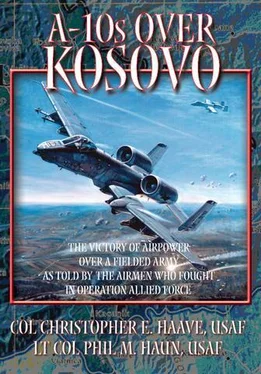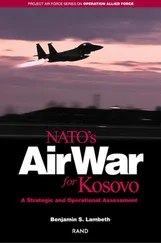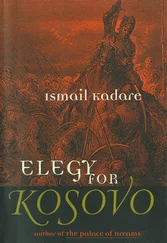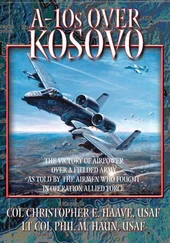Coordination of KEZ Operations
Extensive coordination was required to make the KEZ operations work well. By late April there were dozens of units, from nine NATO countries, which operated from 15 bases and three aircraft carriers to support OAF. Those nations provided aircraft, which regularly flew the indicated missions during KEZ operations (table 1).
Table 1
Aircraft Involved in KEZ Operations
| Country |
Mission |
Aircraft Type |
| Belgium |
Attack [a] |
F-16A |
| Canada |
Attack |
CF-18 |
| France |
Attack |
Super Etendard, Jaguar |
| Germany |
SEAD [b] |
Tornado ECR |
| Italy |
Attack |
Tornado GR.1 IDS, AMX |
| Netherlands |
Attack |
F-16AM |
| DCA [c] |
F-16AM |
| Spain |
Attack |
EF-18 |
| Turkey |
Attack |
TF-16 |
| United Kingdom |
Attack |
GR-7 Harrier |
| Support [d] |
E-3D NAEW |
| United States |
AFAC [e] |
A-10, F-16CG, F-14 |
| Attack |
A-10, F-16CG, F-15E, F-14, F/A-18, AV-8, B-1, B-52 |
| SAR [f] |
A-10, MH-53J (Pave Low), MH-60 (Pave Hawk) |
| SEAD |
F-16CJ, EA-6B |
| DCA |
F-15A, F-15C, F-16CG, F-15E |
| Support |
E-3 AWACS, E-8 JSTARS, EC-130 ABCCC, EC-130H Compass Call, E-2C Hawkeye, KC-10, KC-135 |
| Recce [g] |
Predator, Laser Predator, and Hunter |
Country
Mission: Aircraft Type
====================
Belgium
Attack [a]: F-16A
Canada
Attack: CF-18
France
Attack: Super Etendard, Jaguar
Germany
SEAD [b]: Tornado ECR
Italy
Attack: Tornado GR.1 IDS, AMX
Netherlands
• Attack: F-16AM
• DCA [c]: F-16AM
Spain
Attack: EF-18
Turkey
Attack: TF-16
United Kingdom
• Attack: GR-7 Harrier
• Support [d]: E-3D NAEW
United States
• AFAC [e]: A-10, F-16CG, F-14
• Attack: A-10, F-16CG, F-15E, F-14, F/A-18, AV-8, B-1, B-52
• SAR [f]: A-10, MH-53J (Pave Low), MH-60 (Pave Hawk)
• SEAD: F-16CJ, EA-6B
• DCA: F-15A, F-15C, F-16CG, F-15E
• Support: E-3 AWACS, E-8 JSTARS, EC-130 ABCCC, EC-130H Compass Call, E-2C Hawkeye, KC-10, KC-135
• Recce [g]: Predator, Laser Predator, and Hunter
[a] attack aircraft that employed weapons under the control of an AFAC.
[b] suppression of enemy air defenses.
[c] defensive counterair.
[d] specialized aircraft that support operations in areas of command, control, communications, reconnaissance, intelligence, refueling, and electronic warfare.
[e] airborne forward air controller.
[f] search and rescue.
[g] reconnaissance using unmanned aerial vehicles.
Keeping these mixed gaggles going the same way on the same day required three levels of planning and coordination. First, CAOC planners would build the packages from the available units to ensure the requisite capability. These packages would be published in the daily air tasking order (ATO) and, more importantly, in the draft ATO. The information in the draft allowed the units to get a head start on planning for the next day’s 0600 vul period.
Aviators representing each of the tasked units accomplished the second level of planning in the Wingtip, the wing’s mission planning cell at Aviano. They turned the ATO KEZ package information into two-page “coordination cards” to be used in the next day’s missions. The cards listed frequencies, code words, types of aircraft, and their ordnance. We always had an A-10 pilot there to put the cards together and send them to us at Gioia del Colle. Maj Peter R. “Bro” Brotherton, one of our guys doing his time at Aviano, was the first to appropriately indicate “lots” under the A-10’s ordnance column.
The third level of planning and coordination took place in the units. There, a group of young pilots, under the guidance of a field-grade supervisor, would produce the two-page lineup cards with tasking and tanker information, navigation way points, and weapons parameters. If units wanted to change something on the coordination card or alter their contribution to the KEZ packages, they simply communicated the details to their reps at the Wingtip and the CAOC. This vertical coordination for KEZ operations, after some initial hiccups, ran quite smoothly.
The horizontal coordination among the units participating in hunting fielded Serbian forces did not work as well. During the first week, while most of the “players” were still at Aviano, it was fairly simple for an A-10 AFAC mission commander to drive down the street to pay a visit to the EC-130 ABCCC squadron to work out command and control kinks, or walk down the hall to compare notes with the F-16 AFACs. Once we moved to Gioia de Colle and the F-14 AFACs started flying KEZ sorties off the USS Theodore Roosevelt (CVN 71), coordination among the AFAC units consisted of whatever handoff briefings we managed in the air. In general, we relied too much on the CAOC to provide coordination among units. There was no one playing “Daddy FAC” at the CAOC since there were few, if any, senior FAC-qualified pilots. We knew that the F-16 and F-14 FACs had different capabilities and therefore used different tactics. We had no insight into how they were doing—what did not work, or what worked and got results.
Lt Col Paul C. “Sticky” Strickland ably described our initial situation in an article entitled “USAF Aerospace-Power Doctrine: Decisive or Coercive?” He stated that the initial CAIFF operations did not have an air operations directive to guide them—that is, to provide clear, measurable objectives for the CAOC and the units to attain. [1] Lt Col Paul C. Strickland, “USAF Aerospace-Power Doctrine: Decisive or Coercive?” Aerospace Power Journal 14, no. 3 (fall 2000): 13–25.
Our job was simply to hunt down and destroy Serb weaponry within 10 miles of the Albanian border. Although we enthusiastically applied our talents to this nebulous end, our frustration grew as we went out day after day, often without finding and destroying Serb targets and with no way of assessing our contribution. Certainly we were making a difference: after the first two days, the Serbs stopped driving in convoys, and after a week, they stopped driving armored vehicles during the day. After a month, we knew we had destroyed a significant amount of Serb weaponry, but was the destruction sufficient to achieve NATO objectives?
As FACs we became aware during the KEZ operations of what OAF’s commanding officers have since made public: Gen Wesley Clark was eager for a major NATO effort against Serb fielded forces, while General Short preferred using NATO’s air resources in a concentrated interdiction campaign against Serb infrastructure. (General Short was always a straight shooter with us and essentially explained these preferences during an official visit to Gioia del Colle after the end of the campaign, while graciously praising our contribution to NATO’s victory.) Through our contacts at the CAOC, we learned that, despite the good intentions of many superb officers, this tug-of-war for mission priorities had resulted in ambiguous guidance and a lack of overall direction on our ultimate objective.
Читать дальше












